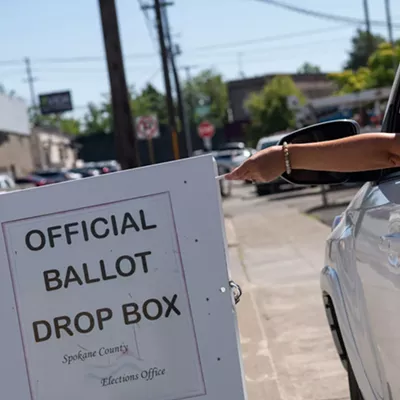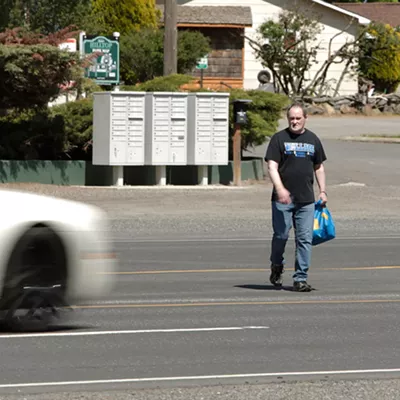On June 15, the Kootenai County Commissioners will finally get to hear details of an agreement that led to the reopening last month of a railroad's leaking refueling depot located atop the aquifer that provides drinking water to half a million locals.
Officials from BNSF Railway and the Idaho Department of Environmental Quality will meet the three commissioners at 6 pm to discuss repairs and new, more stringent oversight protocols at the Hauser Mainline Refueling Facility.
There will be no public comment taken, which disappoints many North Idaho residents who had hoped the $42 million depot would be permanently shut down after it was plagued with a series of leaks and construction flaws shortly after it opened last September.
Some of those critics, conducting a petition drive to move the depot, are hoping concern about the region's drinking water flows across the border to Spokane.
"We are trying to make connections in Spokane. It's more important for Spokane, because they are downstream from the problem," says Cecelia Nothenius, who says the petition drive has gathered 5,000 signatures -- primarily in the Coeur d'Alene area.
Response to the petition has been mixed, with three volunteers only able to rustle up 600 signatures in Spokane on Bloomsday weekend. Working by herself the next weekend, however, Nothenius says nearly 700 people signed the petition at an interstate garden show.
The railroad is also offering a free train ride for about 400 people and small-town mayors who live near the depot. The sold-out excursion, which has been dubbed "Mystery Train to Nowhere" by some Hauser-area residents, is scheduled to leave the refueling depot at 1 pm Friday.
"This is not an attempt to buy goodwill," BNSF public relations director Gus Melonas says from his Seattle office. He concedes the timing makes it appear like a publicity stunt, but Melonas says the excursion train left Kansas City June 4 and will reach Everett, Wash., on June 18, offering short rides along the way.
"The schedule was set last year," Melonas says.
Tickets suddenly were offered to the towns of Hauser and Rathdrum, however, right after the depot reopened.
Annual excursions are "a tradition for our employees and the communities where we operate. We have operated in this community [Hauser] since 1873. We have offered train rides in the past and we will offer train rides in the future. This is extremely popular, and we look forward to sharing this railroad experience," Melonas says.
The county commissioners, meanwhile, are hoping the railroad and DEQ, Idaho's environmental regulatory agency, will share the details of an agreement that ended a court-ordered shutdown of the depot on May 9.
BNSF has been refueling about 25 freight trains a day since the restraining order was lifted. There are storage tanks for 500,000 gallons of fuel at the site.
Idaho 1st District Court Judge Charles Hosack issued a restraining order on Feb. 23 after cracks in the concrete refueling platform were allowing wastewater and diesel to seep through. Faulty seals in one of the two underground liners were also discovered.
In December, railroad workers conducting a regular inspection discovered an industrial wastewater pipe was not clogged as they had suspected, but was cracked and was leaking fuel-tinged wastewater directly into the ground.
DEQ officials estimate 2,000 gallons of the tainted wastewater reached the Spokane Valley-Rathdrum Prairie Aquifer just 160 feet below the depot. The contamination did not reach levels that presented a health threat, DEQ officials said.
The pipe had apparently been leaking since the day it was installed, investigators concluded. Railroad officials estimate they have spent $10 million repairing leaks and redesigning the leak detection and monitoring systems.
The staggering cost and two months of round-the-clock repair work at Hauser has caught the attention of critics such as County Commission Chairman Gus Johnson and others, who wonder what exactly BNSF -- and local residents -- got for $42 million.
"They redid the whole thing. That tells me there was no oversight the first time around," Johnson said last month.
The depot was approved and constructed over the aquifer in a sort of regulatory murk despite longstanding local opposition.
As a transcontinental railroad, BNSF officials argue they are not bound by local or state regulation. And federal environmental oversight is largely nonexistent in this case.
Fine print in the federal Clean Water Act, for instance, doesn't allow the Environmental Protection Agency to act if there is contamination of underground water sources even though the aquifer mixes with the Spokane River at several points. The Clean Water Act also exempts enforcement of petroleum spills, which comes under a different federal act.
But this is why the agreement reached between DEQ and the railroad last month is a good thing, insist Curt Fransen, a deputy Idaho Attorney General, and Marc Kalbaugh, DEQ's inspector at the Hauser depot.
The railroad could squirt away from local oversight but instead agreed to what is, in essence, a contract that details a long list of inspection, monitoring and leak protection measures at Hauser.
Railroad officials such as Steve Millsap, assistant vice president for operations, have seemed genuinely distressed at the shutdown and problems at the depot that was widely trumpeted as "virtually leakproof" when it opened less than a year ago.
Gwen Fransen, DEQ's regional director in Coeur d'Alene, says Kalbaugh and hydrogeologist Gary Stevens, the other main inspector of the Hauser site, will detail why the agency thinks the agreement is a good thing at the June 15 meeting.
"We don't want to miss the target here. We want to be fully responsive and accountable and put things in a clear context and perspective," Fransen says.
The railroad, Melonas says, will be represented by Millsap and Mark Stehly, an assistant vice president for environment.
"BNSF brings out the big guns. We are going with people who are in the trenches and who have first-hand knowledge," Fransen says. "We are not intimidated. We never have been intimidated."
Barry Rosenberg, director of the Kootenai Environmental Alliance based in Coeur d'Alene, says he and several board members met with Fransen and DEQ Director Toni Hardesty to discuss the depot.
"DEQ's hands are not clean in this. They approved the original facility, and six months later it was leaking," Rosenberg says. "They vehemently denied there was any political pressure" to reopen the depot, he adds.
"I don't have any confidence," Rosenberg says. "I believe that depot will contaminate the aquifer. I believe it was built in a shoddy fashion. They just put patches on the thing."
Rosenberg says he is disappointed the commissioners backed away from an initial idea to allow public comment at Wednesday's meeting. Local politicians and business interests have done little to listen to residents who turned out in the thousands to oppose the depot ever since it was first proposed in the late 1990s.
Rosenberg hopes the commissioners will at least use some of a $5 million bond, posted by BNSF, to conduct an independent inspection of the site. He also hopes opponents can gather more than 20,000 signatures on the non-binding petition calling for relocation of the depot -- a number high enough to be hard to ignore.
"People are angry," Rosenberg says. "If this thing leaks again there is going to be even more of an uproar."
The meeting will be held Wednesday, June 15, at 6 pm at the Kootenai County Commissioners offices at the Kootenai County Courthouse. To sign a petition to remove the Hauser Mainline Refueling Depot from over the aquifer, call the Kootenai Environmental Alliance at (208) 667-9093.
Publication date: 06/09/05















